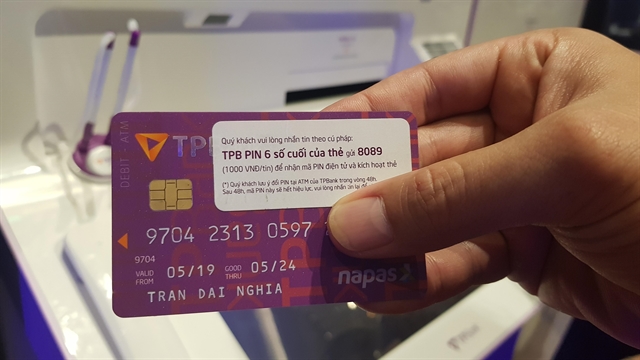 Economy
Economy


|
| A client holds a TPBank card. Việt Nam currently has about 76 million cards issued by 48 banks. — VNA/VNS Photo Thúy Hà |
HÀ NỘI — The Việt Nam Bank Card Association, in collaboration with the National Payment Corporation of Việt Nam (NAPAS) and seven commercial banks, launched the first ATM domestic chip cards to meet EMV standards on Tuesday.
Nguyễn Quang Minh, NAPAS’s deputy general director, said that the chip card was built under special standards for Việt Nam’s market, but follows international standards.
In addition, customers can use both magnetic strip cards and chip cards as the commercial banks upgrade the ATM system to accept the two cards.
ATMs and Points of Sale (POS) in the country are ready for the change and it will only take three months to implement the replacement of the bank cards, he said.
Specialists said that the so-called smart cards contain an electronic chip on the surface with a miniature processor like an independent computer.
The outstanding advantage of chip cards is that the transactions are very fast. With small value transactions, there is no need to enter PIN or signature. This type of card is much safer than the current cards.
“The application of chip card technology standards can limit the copying of information by installing theft-reading devices at ATMs, which will prevent money stealing at ATMs. Statistics show that counterfeit transaction rates fall suddenly when converting from magnetic cards to chip cards."
However, customers are concerned that they may have to pay fees for the replacement.
Calculations show that costs to make a chip card are US$2-3 each, which is seven to eight times higher than the current card.
It is estimated that banks need to invest over VNĐ1 trillion for the replacement, not to mention the expenditures on ATMs and POS upgrading.
Some banks said they could replace chip cards for free for customers despite the big costs, while others said they would have a fee for some customers based on their financial relations, but it wouldn't be applied to everyone.
Đào Minh Tuấn, chairman of Việt Nam Bank Card Association, said the fee for replacement would vary among banks. Banks should have a minimum fee for customers to ensure competition, he added. — VNS